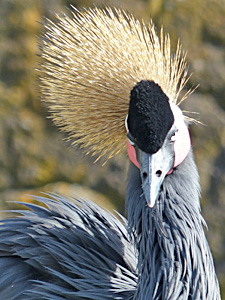
Crowned Cranes
Balearica pavonina & Balearica regulorum
These cousins always attract a lot of attention with their golden dreadlocks. They're the showoffs of the family. ALL cranes dance and sing. I've mentioned that repeatedly. But for some reason, humans are particularly impressed by the dances of these divas. Some people even seem to think that the dances of the Balearica can bring the rain. Silly humans—they're suckers for anything wearing a showy crown!
If that's not enough,
the Balearica cousins have peculiar behaviors as well. You may remember that I told you how to distinguish cranes from the lowly herons? One good clue is that no self-respecting crane would be caught roosting in a tree. The clue here is "self-respecting." These wacky cousins are the only cranes who roost in trees.
Black Crowned Cranes
Balearica pavonina
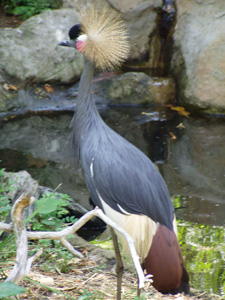
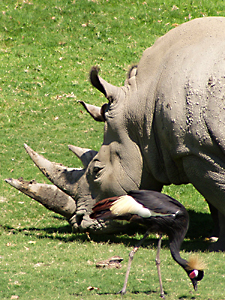
This branch of the Balearica clan is estimated to have approximately 40,000 members in Africa (map of their range). They are classified as vulnerable, primarily because they are so popular with humans, who capture them to keep as household pets. Habitat destruction hasn't helped either.
They like to forage near herds of domesticated animals, because it's easier to find bugs there. But they aren't all that picky about HOW domesticated the mammals need to be.
The Turkana people consider them messengers of peace and protect them, because they believe they get rid of pests and guard waterholes and swamps.
Grey Crowned Cranes
Balearica regulorum
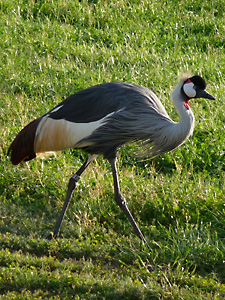
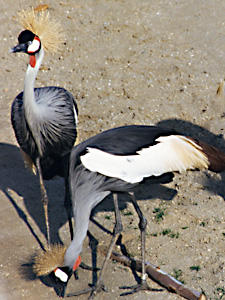
The regulorum members of the Balearica clan used to be well adapted at living around humans. In 2008, these African (map of their range) cranes were classified as a species of least concern. Times have changed, however. An extremely rapid decline of their population has downgraded their status to endangered.
The plunge in their population comes from a variety of problems. Like their black-crowned cousins, they are also trapped to be kept as captives by humans. Habitat loss is particularly significant for them. Their native territory has been subjected to drought and coal mining, as well as the usual pressures of human development.
You Actually CAN Tell Them Apart

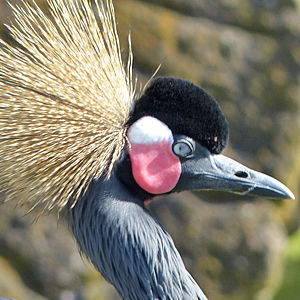
These cousins look pretty similar form a distance. In order to avoid embarrassment at family gatherings, I learned to look at their cheek patches. The black crowned crane (pictured left) has a red and white cheek patch, while the cheek patches of the grey crowned (on the right) are mostly white with just a touch of red at the top. The regulorum cousins are also a lighter grey color and a much larger red "gular" sac under their chins, but that can be tricky to distinguish, especially when you don't have both standing next to each other.
More Crowned Crane Info
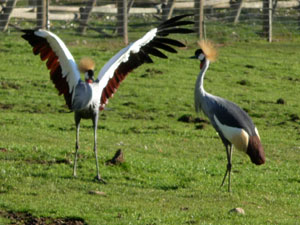

- Their golden crowns seem flamboyant when you look at them against a green lawn, but they are actually great camouflage in the tall grass areas of Africa where they often forage.
- They have "gular sacs" under their chins which can be inflated. Don't ask me why they want to do that. It's just one more goofy Balearica trait!
- They have long hind toes which allow them to perch in trees. Tsk tsk.
- At least 11 different species of crowned cranes once lived in Europe and North America as well. Unfortunately for them, however, they are pretty wimpy. They don't do well in the cold. So when the earth cooled, the northern crowned cranes all died out!
Want to Know More?
- International Crane Foundation : pavonina; regulorum
- Birdlife International: pavonina; regulorum
- ICUN Red List of Threatened species: pavonina; regulorum